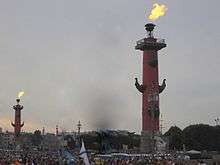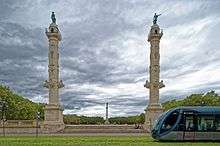Rostral column
Reproduction of the Rostral Column of Gaius Duilius (ca. 260 BC) at the Museum of Roman Civilization.

Rostral columns in Saint Petersburg

Rostral columns of the place des Quinconces, Bordeaux, France
Rostral column erected for Archduke Ferdinand Maximilian by the Austrian Navy in 1876. Originally in Pula, transferred in 1919 to Venice. Artist: Heinrich von Ferstel.
A rostral column is a type of victory column, originating in ancient Greece and Rome where they were erected to commemorate a naval military victory. Traditionally, rostra — the prows or rams of captured ships — were mounted on the columns. Rostral columns of the modern world include the Columbus Memorial at Columbus Circle in New York City, and the paired Saint Petersburg Rostral Columns.
List of notable rostral columns
Ancient
This list is incomplete; you can help by expanding it.
- Columna Rostrata C. Duilii ("Rostral Column of Gaius Duilius"), celebrating the naval Battle of Mylae (260 BC); formerly in the Roman Forum, some remnants of the inscription are now in the Capitoline Museum. [1]
Modern
This list is incomplete; you can help by expanding it.
- Old Saint Petersburg Stock Exchange and Rostral Columns (1811), Saint Petersburg, Russia
- Tripoli Monument First Barbary War
References
Citations
- ↑ Columna Rostrata C. Duilii in Samuel Ball Platner and Thomas Ashby: A Topographical Dictionary of Ancient Rome (1929).
Other sources
- "Greek architecture" Encyclopaedia Britannica, 1965
See also
- Rostra, the raised platforms in ancient Rome, also adorned with the beaks of captured warships, from which orations, pleadings, etc., were delivered.
External links
| Wikimedia Commons has media related to Rostral columns. |
- English translation of the inscription on the Columna Rostrata, Rome
- Images of the rostral column at Columbus Circle, New York City
- Images of the Saint Petersburg Rostral Columns
- Tripoli Monument at the U.S. Naval Academy
This article is issued from Wikipedia - version of the 8/1/2016. The text is available under the Creative Commons Attribution/Share Alike but additional terms may apply for the media files.